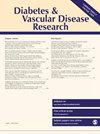Association between dietary folate intake and severe abdominal aorta calcification in adults: A cross-sectional analysis of the national health and nutrition examination survey
IF 3
4区 医学
Q3 ENDOCRINOLOGY & METABOLISM
引用次数: 0
Abstract
BackgroundPrior studies have established a connection between folate intake and cardiovascular disease (CVD). Abdominal aortic calcification (AAC) has been introduced as a good predictor of CVD events, but no previous study has investigated the relationship between dietary folate intake and severe AAC. Therefore, the study aims to explore the association between dietary folate intake and severe AAC in the United States (US) middle-aged and elderly population.MethodsThis study employed cross-sectional data from the 2013-2014 National Health and Nutrition Examination Survey (NHANES) to examine the relationship between dietary folate intake and severe AAC. Two 24-h dietary recall interviews were conducted to assess dietary folate intake and its sources, while a DXA scan was used to determine the AAC score. To analyze the association between dietary folate intake and severe AAC, a multivariable logistic regression model was applied, and a subgroup analysis was performed.ResultsOur analysis utilized data from 2640 participants aged 40 years and above, including 288 individuals diagnosed with severe AAC. After adjusting for confounding factors, we observed an inverted L-shaped association between folate intake and severe AAC. Upon further adjustment for specific confounding factors and covariates, the multivariable-adjusted odds ratios (ORs) and corresponding 95% confidence intervals (CIs) for the second, third, and fourth quartiles of folate intake, using the first quartile as the reference, were as follows: 1.24 (0.86-1.79), 0.86 (0.58-1.27), and 0.63 (0.41-0.97), respectively. Subgroup analysis results were consistent with the logistic regression models, indicating concordant findings. Moreover, no significant interaction was observed in the subgroup analyses.ConclusionsThe study findings suggest an inverted L-shaped association between dietary folate intake and severe AAC. However, additional prospective investigations are necessary to explore the impact of dietary folate intake on severe AAC in patients.膳食叶酸摄入量与成人腹主动脉严重钙化之间的关系:全国健康与营养调查的横断面分析
背景以前的研究已经确定了叶酸摄入量与心血管疾病(CVD)之间的关系。腹主动脉钙化(AAC)被认为是预测心血管疾病事件的一个良好指标,但以前没有研究调查过膳食叶酸摄入量与严重腹主动脉钙化之间的关系。因此,本研究旨在探讨美国中老年人群膳食叶酸摄入量与严重主动脉钙化之间的关系。方法本研究采用了 2013-2014 年美国国家健康与营养调查(NHANES)的横断面数据,以探讨膳食叶酸摄入量与严重主动脉钙化之间的关系。研究人员进行了两次 24 小时膳食回忆访谈,以评估膳食叶酸摄入量及其来源,同时使用 DXA 扫描确定 AAC 评分。为了分析膳食叶酸摄入量与严重缺铁性贫血之间的关系,采用了多变量逻辑回归模型,并进行了亚组分析。 结果我们的分析利用了 2640 名 40 岁及以上参与者的数据,其中包括 288 名确诊为严重缺铁性贫血的患者。在对混杂因素进行调整后,我们观察到叶酸摄入量与重度AAC之间存在倒L型关系。在进一步调整特定混杂因素和协变量后,以第一四分位数为参考,叶酸摄入量的第二、第三和第四四分位数的多变量调整后的几率比(ORs)和相应的 95% 置信区间(CIs)如下:分别为 1.24(0.86-1.79)、0.86(0.58-1.27)和 0.63(0.41-0.97)。亚组分析结果与逻辑回归模型一致,表明结果一致。结论该研究结果表明,膳食叶酸摄入量与重度 AAC 之间存在倒 L 型关联。然而,有必要进行更多的前瞻性研究,以探讨膳食叶酸摄入量对重度 AAC 患者的影响。
本文章由计算机程序翻译,如有差异,请以英文原文为准。
求助全文
约1分钟内获得全文
求助全文
来源期刊

Diabetes & Vascular Disease Research
ENDOCRINOLOGY & METABOLISM-PERIPHERAL VASCULAR DISEASE
CiteScore
4.40
自引率
0.00%
发文量
33
审稿时长
>12 weeks
期刊介绍:
Diabetes & Vascular Disease Research is the first international peer-reviewed journal to unite diabetes and vascular disease in a single title. The journal publishes original papers, research letters and reviews. This journal is a member of the Committee on Publication Ethics (COPE)
 求助内容:
求助内容: 应助结果提醒方式:
应助结果提醒方式:


